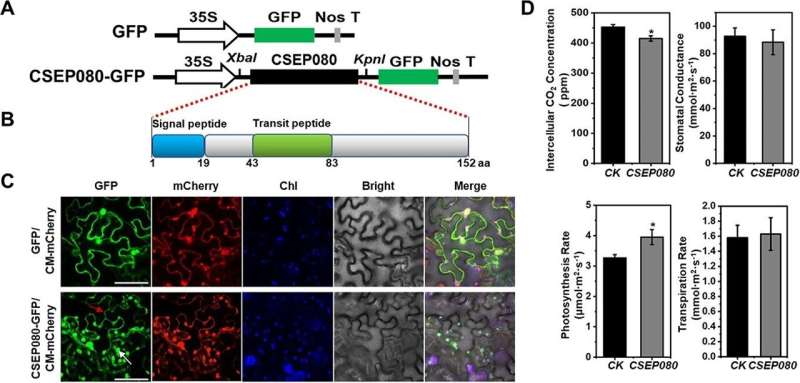This article has been reviewed according to Science X's editorial process and policies. Editors have highlighted the following attributes while ensuring the content's credibility:
fact-checked
proofread
Manipulating host defenses: Unveiling the role of a powdery mildew effector in grapevine infection

Powdery mildew, caused by Erysiphe necator, is a significant threat to grapevine health, utilizing secreted effector proteins (CSEPs) to suppress plant defenses. Despite knowledge of plant immune mechanisms, the specific roles of E. necator's CSEPs in infection remain largely unknown.
Given the economic importance of grapevines and the threat posed by powdery mildew, there is a critical need to investigate the molecular mechanisms of CSEPs in E. necator, which could reveal novel strategies for enhancing plant resistance against this pervasive pathogen.
In August 2023, Horticulture Research published a study titled "An effector of Erysiphe necator translocates to chloroplasts and plasma membrane to suppress host immunity in grapevine."
This study identified the secreted effector protein CSEP080 of E. necator, which was located in plant chloroplasts and plasma membranes. Further experiments showed that this special localization was essential for the function of the effector.
Transient expression of CSEP080 promoted photosynthesis and inhibited INF1-induced cell death in tobacco leaves, suggesting that E. necator might manipulate host plant physiology to its advantage. CSEP080's expression was up-regulated during critical phases of haustorium formation, indicative of its role in effector secretion into host cells. CSEP080 was confirmed as a bona fide powdery mildew effector by yeast secretion assays.
The study revealed the interaction of CSEP080 with grapevine chloroplast protein VviB6f and pectinesterase VviPE to affect photosynthesis in plants through yeast two-hybrid and bimolecular fluorescence complementation assays. Silencing VviB6f in grapevine enhanced resistance to powdery mildew, underscoring the protein's role in the pathogen's infection strategy by modulating host defenses and photosynthesis.
Similarly, manipulating VviPE levels affected pectin content in grapevine leaves, highlighting another avenue through which CSEP080 promotes infection, likely by weakening physical barriers against pathogen entry.
Overall, this study not only elucidates the sophisticated strategies employed by E. necator to infect and damage grapevine but also identifies potential molecular targets for developing novel disease management strategies.
By uncovering the roles of CSEP080 in manipulating host plant defenses and physiology, the research offers insights into the arms race between plants and their pathogens, providing the foundation for future interventions to protect grapevines from powdery mildew infection.
More information: Bo Mu et al, An effector of Erysiphe necator translocates to chloroplasts and plasma membrane to suppress host immunity in grapevine, Horticulture Research (2023). DOI: 10.1093/hr/uhad163
Provided by TranSpread




















